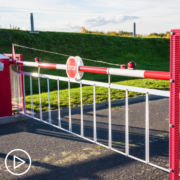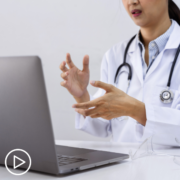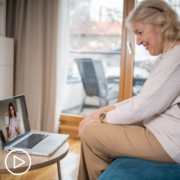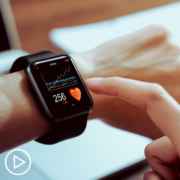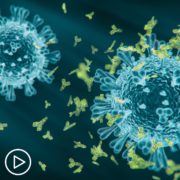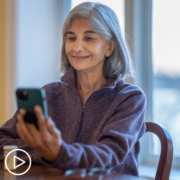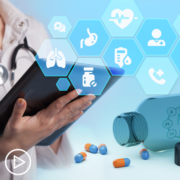PODCAST: MPN Specialized Care and Technology: The Ongoing Role of Telemedicine
Why should MPN patients keep telemedicine in their toolbox post-COVID? How can patients and caregivers feel more confident in voicing concerns and communicating with their healthcare teams regarding telemedicine options? In this unique program, Drs. Jeanne Palmer and S. Joseph Sirintrapun discuss the impact of telemedicine on MPN care and technological tools accelerating the fight against cancer.
See More from the Empowered! Podcast
Transcript:
Lisa Hatfield:
Hello and welcome to this Patient Empowerment Network program. I’m your host, Lisa Hatfield. And in this unique program, we are going to explore cancer care and technology, specifically the importance of specialized care in myeloproliferative neoplasms and the ongoing role of telemedicine. And just to abbreviate myeloproliferative neoplasms going forward, I think we’ll just use the acronym MPNs, it’s a little bit easier to say. So today, I’m joined by two incredible experts. Dr. Jeanne Palmer is a respected hematologist oncologist, treating MPNs at Mayo Clinic. Dr. Palmer’s a Program Director for the Blood and Marrow Transplant Program. And, Dr. Palmer, it’s really a pleasure to connect with you today. Thanks for being here.
Dr. Palmer:
Thank you for having me. I always enjoy coming to these presentations and being able to share some knowledge.
Lisa Hatfield:
Awesome, great. Well, thank you. We also have joining us, Dr. Joseph Sirintrapun, a noted clinical informatics expert from Memorial Sloan Kettering Cancer Center. And for some of our audience members, this term informatics may be unfamiliar or new to you. So briefly, informatics integrates the worlds of medicine and technology, and, Dr. Sirintrapun, it’s really nice to connect with you also. This is something that I’ve been wanting to learn more about anyway, the merging of medicine and technology. So it’ll be great to talk with you today. Thank you.
Dr. Sirintrapun:
Well, thank you for having me, I appreciate it.
Lisa Hatfield:
Thank you. We’re going to have a real-time look at telemedicine. I like to start with the current landscape and the ever-changing yet ongoing role of telemedicine. So starting with, Dr. Palmer, how does telemedicine work, and how does an MPN patient ask for or access telemedicine? How do you do that at your center?
Dr. Palmer:
So telemedicine has been a real…one of the blessings that’s come out of this whole COVID pandemic because it put fast-forward on the development of it and certainly has opened a lot of doors. I think one of the beneficial things of telemedicine is in a disease like MPNs, these are very rare diseases, and there are not a lot of specialists in the country. So depending on where you live, there may or may not be somebody who specializes in this disease focus. So by having telemedicine, you can have access to a provider who has a higher level of specialty in that specific disease. I think this is really important for any rare disease, just because of the difficulty in finding specialists. Many of them are in urban areas. And so if you live in a rural area or somewhere outside of that specific zone, it can be very difficult to come and see a specialist. Additionally, it can be very costly.
If you look at the cost of the airfare and the lodging and everything else, I think of people coming to Scottsdale can pay an enormous amount of money just to come for two nights and to be able to see me. So the fact that we can do this via telemedicine, they can get the information, receive the education about the disease and help for maybe their local provider and managing it can make a huge difference in the quality of care.
Lisa Hatfield:
Great. Well, thank you. So from a practical perspective and if you have a newly diagnosed MPN patient and they wanted to get specialized care or talk to an expert, would they just call…would they just look up online and find a phone number and try to call your clinic? Or how would they get access maybe as an expert opinion from you, via telemedicine?
Dr. Palmer:
So as of right now, the best way to access it is if you go on to the Mayo Clinic website, there’s actually a referral phone number where people can self-refer for a consultation. Now, the changing part of this, the changing part of this landscape is that right now we’re still in the public health emergency. So a lot of the barriers between seeing patients in different states based on…because I have a license in Arizona, I don’t have a license in another state. That’s going to become a bit more challenging because of the fact that if the physician…like, for example, myself, if there’s a patient who wants an opinion who lives in Nebraska, I don’t have a Nebraska license. So therefore it would be a lot more challenging, because I can’t actually do an initial consultation via telemedicine once the public health emergency ends.
I think this is a really important thing that needs to be worked on, probably on more of a legislative level of trying to change some of the rules and laws associated with this. And something that I know there’s a number of people working on, but as of right now, and I think…I don’t remember when the public health emergency will be ending, but during the public health emergency, it’s just been a matter of just calling in like you’d normally try to get a consult. However, that will change and hopefully, as more awareness of telemedicine and some of its benefits are really understood that some of these laws can change and some of these processes can change so that they can allow people to get access to care they otherwise wouldn’t be able to receive.
Lisa Hatfield:
Yes, I appreciate that, and I will be a fierce advocate out there trying to have those telemedicine benefits continue, because I do come from a more rural state, so I appreciate those.
Dr. Sirintrapun:
Can I jump in?
Lisa Hatfield:
Yes, please do. Yeah.
Dr. Sirintrapun:
To help answer some of the points that Jeanne had brought up. The American Telemedicine Association works very hard in terms of looking at the same problem about the state laws, being able to be licensed and have ways to overcome state barriers, and then another one about the public health emergency…and it is true, I’ve been hearing that it’s going to end some time in a couple of months, so that’s one thing to keep in mind as well, and they’re going to have to look in terms of what to do afterwards. Because there’s a lot of things that patients enjoy, providers enjoy that they’ll have to continue that technically go away, but we don’t necessarily want to see that go and so these are the things that we’ll have to keep in mind moving forward after the public health emergency ends.
Lisa Hatfield:
I appreciate that, and I think you’re right, and I think that telemedicine has had… It can have a detrimental impact on outcomes for patients too, and to remove that would be devastating for some patients like myself. All right, so Dr. Palmer, the COVID pandemic has resulted in significant changes to many aspects of daily living for all of us, but for patients like myself who are living with cancer, there are different realities that we have to deal with, so can you give a brief overview of the impact that COVID-19 has had on MPNs.
Dr. Palmer:
So I think the impact of COVID-19, I think we just spoke about some of the favorable things that telemedicine became a real reality, some of the detrimental things, enrolling in clinical trials has been very, very difficult because of the fact that, number one, the public health emergency, some patients weren’t able to travel. And then number two is, I think there has been sort of an exodus of people working in healthcare, I think healthcare has become extremely stressful because of all the pressures associated with the COVID pandemic. So having the appropriate staffing for clinical trials has been difficult, but one of the things that I think is coming out of this that I think will be really positive is there are a number of studies that are being looked at now that are actually creating ability to have some of the visits done by a telemedicine. So taking what’s not as critical to be seen in-person, and what labs we don’t need to necessarily get that need to go to a central processing area, but there are actually ways that we are working with home health care companies with different labs to be able to provide some of this ability to do telemedicine, especially on the clinical trials where there’s monthly visits.
I have had patients travel from multiple different areas of the country to be on clinical trials. I’m usually more in the southwest or at least the West Coast, but I think that with some of these changes, it’s going to be a lot more of a reality for it. So I think some of the pressures of the COVID pandemic will…again, there will be sort of a silver lining of it, and that we may have this ability to do that, because even if I looked at…you look at the pre-COVID clinical trials, if there was a trial that needed monthly visits, which a great number of them do. I would say the majority of my studies that I have for patients with MPNs require monthly visits, at least the first six months. Being able to have that extended out is hugely important and will allow access for it, so if we can have a virtual visit, even every other visit, that can make a big difference in somebody’s ability to access new treatments.
Lisa Hatfield:
All right. Well, thank you again, the push for continued telemedicine benefits would be great. So another question for Dr. Palmer, is technology playing a role in accelerating progress in MPN care, not just the technology of telemedicine, but other technologies? And what role does technology play in symptom management and in clinical trials? You mentioned that you can maybe do telemedicine every other month, but what other roles does technology play?
Dr. Palmer:
So that’s a great question. I actually have been fortunate enough to work with an informaticist who will be joining our faculty this summer, and what we are trying to do is be able to utilize our electronic medical record and some of the forms and texts that you can use within it to be able to capture data and be able to understand it. From the standpoint of even my day-to-day practice, one of the things that’s very important in myeloproliferative diseases is capturing the symptoms score. And this is a way of measuring some of the symptoms that can be very bothersome and troublesome to patients with myeloproliferative diseases and has been validated and utilized throughout multiple studies and multiple settings. So I’m actually in the process of getting that built into our EMR here, so that before patients even come and see me, they can fill out that form of questions. And I think that the sky is the limit. There’s so many patient-reported outcomes and so many things that are going to be important to capture as we move forward. And a lot of times you can ask somebody, “How do you feel?” And they say, “Oh, I feel great.”
Because what else are they supposed to say? Social norm is to say everything’s fine, and then you start to ask them specific things like, “Are you having itching? Are you having fatigue?” And all of a sudden it comes out that they’re really not feeling that well. So this will be really important, and if you can have people do that beforehand, and I think that we can gain a lot of information that can really help utilize the small amount of time we have to focus it on the areas that need to be focused upon.
Lisa Hatfield:
That’s great to hear. Yeah.
Dr. Palmer:
Yeah, the other thing that I didn’t mention is that I think being able to do research. It will be very helpful if we can capture all the data about patients in a way that can be outsourced to a database and then analyzed versus having to hire people to extract information directly from the chart, which is a very laborious process and often not very accurate. So that’s one of the things that we’re working on here is to say,” How do I not only create this template for capturing information from the patient, but how do I make my clinical notes into something that can be harnessed for a database that can then be queried for different questions to try to understand the disease better?”
Lisa Hatfield:
Well, and that is a great segue into what we’re going to talk about with Dr. Sirintrapun. So, Dr. Sirintrapun, as far as informatics goes, can you give us the lay person or a patient-friendly version of what informatics is and what it means for cancer care?
Dr. Sirintrapun:
I really appreciate Dr. Palmer giving the segue for the informatic system. So this is…let me start with maybe when I explain to colleagues and other people about what informatics is. When you think of informatics, you think of three pillars, and we always..I almost have it down like a parrot. So it’s people, processes, and technology. And people always think it’s the technology, but it’s also people and processes, and that’s always been…whenever you see informatics, that’s the three pillars, but I wanted to add one more that Dr. Palmer also mentioned is data and information. You incorporate all those, so imagine all the four pillars coming together to enable the practice of medicine care and at a very high level, what I like to think of informatics is, it’s the science of bridging the gap, decreasing the chasm between the right caregiver to the patient who needs it. Because there are chasms everywhere, in terms of logistics, space, physicality, you have to travel five states to get help with a rare tumor.
Those are chasms there. And I see informatics as bringing all those different pillars together. How do we do it so that the chasm is decreased? Or if it’s not a chasm, decreasing the friction, decreasing the burden between making these things work, making things more efficient. So I think I was hearing a little bit earlier about how can we automate things? As Dr. Palmer mentioned before, data, data abstraction data, being able to pull data from these gigantic enormous resources, it’s tough. And it’s not like we can hire the entire high school student population on their summer internship to go and read through these notes. And there’s not enough money, there’s not enough knowledge. And we need to find different ways that we can use automation, AI, or other things like that to do it.
And this is where informatics kind of delves in. How do we apply all these different things so that people can use it, because you never can forget about people. It works in the processes that take place and it’s the right technology. Because sometimes technology, it’s a great technology, but it’s not ready for certain things. I see a lot of technology kind of ahead of its time. It’s basically a tool in search of a problem and people try to stick it somewhere where it doesn’t fit. So it’s a lot of that. And as you can tell, I’m pretty excited about it because that in a nutshell gives you a feel of what informatics is all about, so.
Lisa Hatfield:
Great. Well, thank you for that. So pre-pandemic…we were talking a bit with Dr. Palmer about telemedicine. Pre-pandemic, you and your colleagues explore the role of telemedicine in cancer care. Can you give a brief overview from your perspective, how telemedicine has evolved and continues to evolve and how you think it might evolve going forward? I guess that’s what evolve means, but. [laughter]
Dr. Sirintrapun:
Yeah, I think I like pulling out these old sayings and I think Winston Churchill was credited with it even though I don’t think he said it, but never let a good crisis go to waste. You probably heard that during COVID, and COVID really blew open the door for telemedicine. I think because we just had to, there was no choice behind that. And thankfully, people…organizations, people recognized it. And I remember in March, March 2020, the public health emergency was declared and a lot of different things that were barriers and a lot of them were regulatory. They were opened up so that it can enable reimbursements, all these different things that factor in. And being able to leverage the technologies, because keep in mind with providers, I knew providers that didn’t know how to use Zoom and other technologies. And because of COVID, they were forced and they found out, “Hey, it’s not that bad.” But if I were to do that before the pandemic, they’d be like, “Well, why should I? We’ll just show up in this conference room. We’ll just be there at six o’clock in the morning.”
So it opens people’s minds. And I think that really helped. I don’t think that Genie’s going back into the bottle, not at least completely. I think we’re going to figure different ways to leverage those technologies moving forward. So in terms of telemedicine moving forward, some of the things I’d like to see and hence I think this is maybe one of the reasons why I’m here, is like how do we enable clinical trials to embrace the telemedicine model? Because clinical trials till now historically has been kind of a physical model. You have to go to some ivory tower, some centralized place and that really limits down, the patients can do it. There’s access problems. Even if you had the richest study in the world, you had to fly people from all over the world. You can imagine that just drains the budget. There are just all these different things there. And when you think of the way clinical trials are conducted, it didn’t really take into account telemedicine visits.
At my institution Memorial Sloan Kettering, we developed an entire ecosystem of telemedicine tools to actually try to encompass the patient experience as close as we could. Because the experience, it can never be completely duplicated, but you can do certain things definitely through telemedicine. We tried to do our best to do it so it’s easier for patients, the nurse coordinators as well as the providers to use that. And clinical trials, they’re moving towards it. They’re acknowledging the issue and they’re rethinking the ways to do it. How can we enable it so that we can decrease the chasm between the patient and being able to enroll in a clinical trial? So in a nutshell, that’s the way things are going. We’re not there yet, but we’re definitely thinking about it. It’s definitely a discussion. I think the future will see a much more clinically- and a telemedicine-enabled clinical trial framework.
Lisa Hatfield:
That’s great to hear. For patients, I think that’s really, really encouraging to hear that we’re utilizing that technology. So in addition to the telemedicine technology, there are other types of technology that are influencing cancer care. Can you speak to some of those technologies? I know I’ve always been really interested in the CRISPR technology, which I don’t hear about as much anymore. Artificial intelligence, my oldest daughter is graduating from college this year. That’s what she’s studying. So can you touch on some of those technologies and how those are continuing to evolve also?
Dr. Sirintrapun:
Oh yeah, there’s a lot. So maybe as a disclaimer also, in addition to being an informaticist, I’m a pathologist. So it’s a great honor to speak in front of patients, because many patients may not necessarily know whenever you get a diagnosis, there’s a pathologist who made the diagnosis on a glass slide through a lab test. So that’s my path as a pathologist. So a lot of my technology mindset is in terms of diagnostic. So how do you make the diagnosis better? And you mentioned about…well, I mean, we’ll start with CRISPR. CRISPR is not necessarily in the diagnostic front, but it’s a very exciting thing, especially for those tumors that have genetics. One of the simple genetics. You misplace one gene here, and all of a sudden it just alters the way one protein goes, and it leads to a disease, a cancer. And if you’re able to surgically or genetically microsurgery, you can imagine the implications and the transformation for that.
We’re already looking at it with hereditary diseases like Huntington’s and some of the different blood disorders out there, which have like single genes or maybe a couple that you can just sort of pick out there. It’s still early. And that’s maybe the reason why you haven’t heard the technologies there that can do it. But how to deliver it, how to do the microsurgery. You can have the scalpel, but somebody has to hold the scalpel and how to do that in terms of what type of nanotechnology is out there, all these different things. But CRISPR is very exciting. I do expect over the next, definitely in the next couple of decades, you’ll see something, some brilliant application coming out of that.
Now you mentioned AI, that’s definitely down my wheelhouse because I implement a lot of…I see a lot of AI, and I try to figure out different ways to implement the AI into healthcare. Because there’s tons of AI out there, but the idea is to basically use the right AI at the right time with the right person using it and for the right problem. And there’s a lot of rights in there, and it sounds simple. But you have to keep in mind that in the AI world, we sort of separate AI into like general AI and narrow AI. General AI is kind of the, is what some people term the singularity. Like it knows everything. It can read your mind. You can switch the setting of whatever it is. It can write poetry in one setting, play the piano in another. There really is no such thing.
So if you hear ChatGPT, if you ask it to play the piano, it’s not quite applied for that. It’s really for language. And I try to illustrate that point because that…all these AI currently that’s out there is still in a narrow AI. It doesn’t do what a person does. As people, we can switch. We can task switch. We may not beat the robot, but we can certainly task, if the setting changes, we can adjust. And that’s the power with our intelligence. We’re generalized. While most AI is narrow, but very good. They can be…obviously, when IBM Watson beat everybody at Jeopardy, and now you hear ChatGPT beat people in passing the boards. So a lot of med students are going, oh my gosh. Keep in mind that it’s narrow. I mean, this is what the robot is really good at. They’re very good at facts. They’re good at other things. And you can use that. You can, but they’re not going to be able to task switch.
And they’re not going to be able to know when they need to deploy the right situation. Remember, they’re narrow. So they’re not going to know when you change a situation. It’s not going to know when to switch. That’s the job of a physician, maybe the patient. And it’s my job as kind of the engineer or an informaticist to figure out when those come in. When should it trigger at the right time? When to make sure that people don’t misuse it at the wrong time and deploy the right problem to the right AI. And so, for instance, as a pathologist, one of the big hottest things that we have right now is prostate biopsy. I deal with male cancer. So I deal a lot with prostate. But the AI is pretty good at actually even, I would argue, probably getting better at catching cancer in a small prostate biopsy than humans are. There are small things that maybe, for whatever reason, human factors being tired, the AI can actually catch it quicker.
It might overflag. It might catch things that are not necessarily cancer. But it will catch it. It will catch it. And it can be very helpful. Because you can imagine as humans tire, they can use that to screen. It may not be perfect at diagnosing, but it can screen. And at least it won’t miss anything. And then the human, the pathologist who comes in, can go and say, I can confirm that that’s cancer or not. So you save a lot of mental power, mental energy in terms of things. And this is an application of AI helping providers, and I can see in the future even patients sort of answer questions that would have been very laborious, tedious. This goes back to the automation theme that we had earlier. How do we make things easier? How do we decrease the friction? I sort of illustrated a case where they had friction points and tiredness and things like that. And so these are things that are on the horizon.
And I think we’ll learn a lot in the next decade or so. You’ll see a lot pop up. You’ll probably see some mistakes too, people overusing it or being in the wrong situation. But that’s the way medicine works. Medicine works through some trial and error. You make your best guess. You have experts. But in the end, there’s a lot of unforeseen things. But you learn a lot along the way. And you learn when to use it. And eventually, you reach this equally important point where everything works very well. It’s part of the workflow. It’s just part of…you just expect it. It’s just when you go to care, you just expect that there is a human overseeing some AI that’s making sure that you’ve got the right diagnosis that nothing’s left out, nothing’s omitted, and you can trust it. That’s kind of the place you eventually end up being.
Lisa Hatfield:
Well, and you hit right on something that I think a lot of people worry about is how can we trust AI and all of the ethics surrounding that? Can we really trust AI? As a patient, I’m fascinated by that. And I know that the Cancer Moonshot Program has directed some funds to AI and cancer research. I look forward to the day when there’s a bridging of that gap between research and then clinical practice with humans involved in a lot of the decision-making along the way also. I’m not sure that we can ever move away from that. But that was a great overview of technology. I hope it continues to evolve. I hope what I’ve seen, what you talked about, you work more in solid tumors. I have a hematologic cancer myself. But I do see that there is some AI being used in earlier screening and also in the identifying of different genetic mutations within those cancers. So I look forward to that continuing to evolve.
Dr. Sirintrapun:
That reminds me, too, and I left that part out. Some of these technologies…I’m sorry I left that out, but genomics has become a big thing over the last decade because of the Cancer Genome Atlas and other things that actually allowed us to map the genome. But along that front, we have technologies that can monitor progression. So we can at the cellular level. If you’re actually circulating cell-free DNA as a technology that’s out there. Where if you can implement it correctly, you can actually follow the patients just through blood without anything invasive. And it’s much better than any imaging study out there. So there are technologies that are evolving on this. And because of all the progress we’ve made over the last 10 years, you can see that being incorporated in a clinical trial where you can monitor patients much better. You can intervene faster and more effectively and all those other things like that. And thanks for reminding me about that. I forgot to mention cell-free DNA is another one that I’m very excited about, still early.
Lisa Hatfield:
Yeah. Well, thanks for that information. Dr. Palmer, do you have anything to add to this informatics description or discussion?
Dr. Palmer:
Well, I think there’s a couple of things about the technology component of it. I know it was several years back, CRISPR, when it first came about. It’s a brilliant technology. Everyone got very excited. Okay, if you look at a lot of the myeloproliferative neoplasms, there are three driver mutations that are really felt to contribute strongly to the development and the ongoing nature of the disease. Everyone said, “Oh, I can go in and if you take out that gene and replace it with the new one, I can fix it.” I think that where the role of CRISPR right now is, is it’s doing amazing things to help us understand the biology of the disease.
I think in terms of treating a lot of the malignancies, they’re so genetically complex that even though we say, okay, well, you have, for example, a JAK2-positive essential thrombocythemia, which is JAK2 is one of the driver mutations and essential thrombocythemia is too many platelets. Unfortunately, I probably can’t go in there and get all the JAK2 mutations in the blood system to replace them. Now, where it is making huge strides is in things like sickle cell disease and thalassemia, where there is one gene that is the problem. And even if you only replace it in 50 percent of the cells, you can really drastically change somebody’s life. So I think that it is used in certain situations and is absolutely astounding and amazing. I think its utility and completely eradicating cancer is going to be something that is going to take a long time to come about. But I do acknowledge that it’s making enormous strides in understanding how everything can work, because you can quickly remove something, replace it with something else, and really understand what the function of that mutation or that gene happens to be. In terms of the artificial intelligence, I’m looking forward to seeing how it can be used.
I think it’s right. You try to find, how can I come up with the right answer? And once you think, “Oh, this should be easy, I should be able to look at somebody’s blood counts over the course of a year and be able to predict something.” But to actually be able to do that, I think, is going to take a lot more thought. So it is something that I’m hopeful that we can all start to utilize more. I think the last thing is, is some of these really fancy ways of detecting minute amounts of diseases. I think circulating DNA, which I frankly don’t know a lot about, because I don’t treat a lot of solid tumors. But also, when I look at just bone marrow disorders, like acute leukemias, we often look for something called minimal residual disease, which is this below the microscopic level. You’re looking at like one cell out of 0.001 percent of the cells.
And honestly, we don’t really know how to deal with that. And I think sometimes it ends up providing more anxiety, because you have otherwise a disease that you would say, under all historical purposes, you’re in remission, this is great. And then you have this little amount of disease. And sometimes it’s good, because it can help us determine the next steps of therapy in a more effective way. But sometimes it just creates stress, and we don’t truly know the actual meaning of it.
Lisa Hatfield:
That’s a really great point, the minimal residual disease, is we’re testing such a deep level of sensitivity. Do I want to know that much, because would it be treated anyway? Will it make a difference? Or will I be overtreating a cancer with the chemotherapy agents or agents that are more toxic? That’s a great point you bring up.
Dr. Palmer:
Yeah.
Lisa Hatfield:
So, yeah.
Dr. Palmer:
It’s a very difficult one. As we get more and more of these tests, we’re finding more stuff that we don’t really know what to do with.
Lisa Hatfield:
Yeah. So and I just want to take a step back really quick. So we were talking about the CRISPR technology. And, Dr. Sirintrapun, if you can just clarify for me, for any patients watching this, so CRISPR is the technology that is used, or the methods used to edit genes. Is that correct? It’s not an actual therapy a person can receive. But it’s the technology that’s used to edit genes.
Dr. Sirintrapun:
Yeah, it’s just the technique.
Lisa Hatfield:
Okay.
Dr. Sirintrapun:
But it’s not…but yeah, therapy is a bigger…you can imagine therapy being a big umbrella. And then the technique would be there. So it’s more…
Lisa Hatfield:
Okay. Just wanted to clarify that for people watching this, since we’re talking about that CRISPR. So and Dr. Palmer had touched a little bit on the personalized medicine for MPNs, looking at specific mutations like the JAK2 mutation, MPL mutation. Dr. Palmer, can you share some examples of how telemedicine is influencing personalized medicine in MPN care?
Dr. Palmer:
So I think one of the key…so when we look at treating different myeloproliferative neoplasms, you have to take what’s your goal of therapy. So for the ones like essential thrombocythemia, where you have too many platelets, or polycythemia vera, where there’s too many red cells. A lot of times what you’re doing there is you’re just saying, well, how can I predict whether you’re going to have a blood clot or something? Because people can live, these can be fairly chronic diseases that with appropriate therapy, people can live a long time.
So a lot of that’s risk mitigation. Where I think a lot of the personalized aspect of it is coming in is probably in myelofibrosis, which is a disease where I view it as too much inflammation, scar tissue develops in the bone marrow, people could get a large spleen, high white blood cell count. A number of different manifestations. And in that, we’re learning more and more that in addition to the three driver mutations, the JAK2, the MPL, and the calreticulin, there’s probably a whole other group of mutations that can really be used to help us predict and try to take a look into the future to help guide them. And what is the timing for transplant? Should we be more aggressive as we’re getting more and more agents being evaluated and hopefully approved in the treatment of myeloproliferative diseases? Who are the people who should utilize these agents?
Because again, you don’t want to overtreat. And so I think that being able to hone in on these different mutations to be able to help us predict what we think will happen and maybe different treatment options that we would have, that’s going to be important. Now, one of the things that’s really exciting is that some of these companies that actually do this deep sequence, like looking at multiple, multiple genes, actually have mechanisms by which they will send somebody to a person’s house and then draw the blood and take it over and run it. And so I’ve actually had that done before, where somebody I saw via telemedicine, and we really wanted to get that information so I could appropriately advise on what I anticipated was going to happen in the course of the disease.
And we were able to actually get that information through using home care, saying, I want this order to be done. The home care people went out, drew the blood, sent it to where it needed to go in the right format, and I was able to get that information. So I think that telemedicine allows them access to people who understand how to interpret that information. But I think we have to give a lot of props to a lot of these companies that are really getting innovative in how they’re capturing the data, saying, “No, you know what? You don’t need to have this done in Scottsdale, Arizona or Phoenix, Arizona. You can have this done in your own home and wherever your home happens to be.”
So I think that that type of thing is really changing some of how we can utilize that data that’s very personalized, but be able to use it in a telemedicine format where we don’t need people to physically come here to get their blood taken. Now, I do want to add the caveat. There are a number of different institutions that have enormous amounts of lab work that’s looking at things above and beyond the approved tests that have been validated and everything. And that would be a lot harder to get. There still are ways of doing that, but I think that we have to acknowledge that there is something that we do lose by doing that. Although I can get a lot of information, be able to provide a lot of input to a patient. It still doesn’t address the fact that by physically being there, sometimes you can get samples that you can biobank, and you can send to somebody’s lab. And then these are the people who are discovering the new things that really that’s how we learned what we know so far. Is because somebody went and looked at these genes and more and more and more of this is going on. So I want to temper this with saying not everything can be done by a telemedicine.
That we have to be thoughtful about our approaches and really utilize combining in-person visits along with telemedicine to really do care. And to give an example, what I do for patients is if I follow them by a telemedicine only, I won’t actually be a prescribing doctor. I won’t be a primary provider. I have to at least see them once a year if I’m going to give medicines or do things like that. So I think that there’s a hybrid model that’s going to be really important to do as well for patients who are able to do that.
Lisa Hatfield:
Thanks for that.
Dr. Palmer:
If that makes…yeah.
Lisa Hatfield:
It does make sense. And I just had a quick question too. So if I’m coming in or I’m going to see my…I’m a newly diagnosed MPN patient going into my local oncologist. I’m watching this webinar and I hear, “Oh, if somebody came to my home. I could maybe do telemedicine, or I can have somebody come to my home and take my blood and look at these genetic mutations. My local oncologist doesn’t know exactly how to go about doing that.” Would that be the point where they might try to contact a specialist or go through the consult center through Mayo Clinic or somewhere to say, “Oh, I need a specialist to help me access this type of testing?”
Dr. Palmer:
So I have to be very honest. I just learned about this type of testing in the last year or so. And so it’s something that I’ve started to be able to utilize. With myeloproliferative diseases, I think, and very honestly, and there’s a number of us specialists around the country, I think everyone seeing one at least once in terms of just saying, “Hey, what’s our plan of care going to be?” Are we looking at all the angles of it is a really important thing to do. And I think there’s a number of excellent physicians out there in different parts of the country that some of whom are using telemedicine, some I’m not sure that they are. But I think that getting that specialized opinion is extremely important. I think then in terms of managing care, there’s multiple… Give me a second, I’m sorry. There’s multiple ways that can be configured that will help take care of the patient depending on their individual needs and their ability to travel and everything.
Lisa Hatfield:
Okay. That’s really helpful. Just as someone who has an excellent local oncologist but we don’t do some of the tests here. So that’s why I see a specialist. And they send me actually a kit, a lab kit to have something sent back to Mayo Clinic. And I love that. It makes it so nice to know where I’m at with my disease.
Okay. So, Dr. Sirintrapun, the importance of connecting to specialized care when living with a rare cancer is so paramount. But with anything comes risk and rewards. What are the risks and rewards of telemedicine and maybe even some of the limitations? You both touched on that a little bit. But if you can talk about that a little bit, that would be great.
Dr. Sirintrapun:
Yeah, I’m so glad that Dr. Palmer actually illustrated to everybody, including myself, kind of how the processes work and if you had a trial, particularly with monitoring, and getting the right tests. So being a pathologist, that’s the other hat, I look at glass slides, but I also handle a lot of tests in particular, is looking at them. And in Memorial we do those complex humongous genome panels, it’s actually become much more commonplace to have 500 genes. And as Dr. Palmer had alluded to, sometimes you don’t know out of the 500, which are really meaningful, which are not. But out of that, you do know with some of them. I see it like the initial diagnosis, at least with technology, like the complex testing being done, still centered. It’s hard to outsource that to locally.
But in terms of convenience, I can see a future where a lot of these tests can be done more closer to the patient, where they’re simpler, there’s more automation. Somebody who might be a lab tech or nurse practitioner might, the instrument might be simple enough to press a button, and you’ll get your results. And that’ll be just the right amount of genomes to monitor. Now going back to rare diseases and such, it depends on the rare disease. Because rare diseases have been kind of the classic paradigm for a clinical trial where you have to go to a centralized center because a lot of times the way rare diseases work is that they’re, at least in pathology, there centrally to an expert. Because there’s only one person that’s ever looked at it in the entire world and nobody else really knows. And you end up sending it to that guru.
And so the problem with that is that somebody has to know from the outside, “Hey, I think it’s this, I should send it to that person.” So you have, you already have friction and a gap right there. And you have the logistics of it just, okay, once it’s there and you get the diagnosis, what happens next? Can the patient who might be living from wherever be able to go and get enrolled in that trial? So you have all these different barriers that I alluded to before. So the advantage of the telemedicine is that you basically might have diminished the gap. You can bring that expert in terms of consultation to the patient who lives very far away. Now, going back to all the logistics about monitoring, if you had the right lab tests, and this is where the FDA comes in, and we don’t have time to go into the way lab tests are developed, but if the lab test is simple enough, you can do the monitoring more closer to the patient.
And in that way the clinical trial is much more enabling. They don’t have to fly somewhere, you have to go some…it all depends on how they can actually get the test to the right quality level and closer to the patient so that you can have the monitoring as more frequently, and you don’t have the cost of actually having to ship either the patient or the sample elsewhere. So things that are changing, I’m hoping, because the technology’s there, and it takes architects of clinical trials to rethink that. What’s the right technology now that we can apply it locally, so that we don’t have to do all this back and forth. And so that’s the type of thing. So going with the record, there’s lots of opportunity. I think the cautionary part would be is that tech, if you’re going to deploy something, let’s say near the patient, we call it point of care in lab testing, point of care, right?
Right, right near the patient. You have to make sure that lab test is quality, it’s actually good enough, like it met all the standards, and then you can trust the results. That’s the trick. And that’s where the cautionary part comes in. Are these things really good enough that anybody with a little experience can use it and that people can interpret the result and you can trust the result. That all these things are in place. I’m giving you the ins and outs with the way, when you want to deploy something, these are the different things you have to consider. But there’s a lot of potential as I mentioned.
Lisa Hatfield:
Sure. Great. Dr. Palmer, do you have anything that you want to share or add to that? Risks, rewards, limitations for MPN patients about telemedicine?
Dr. Palmer:
So, I think that brought up a really good point. So when we look at these tests that you can order, I think there’s a lot of companies that do very reputable tests that are even sometimes utilized by some centers. And so at the first diagnosis, I think there’s the piece that what is going to help clinically based on the knowledge that we know, and that is some of these tests that actually can, are very good quality have somebody to be deployed, draw the blood, send it to wherever and do the test. Sometimes it’s good to be at the center itself where there are actually labs and that increases the learning. I think that the architecture of the clinical trial which was a great way to put it, is going to be really important, because if I take a complete blood count, honestly, I mean, anyone can do a complete blood count and I can get the information that I really need to get out of it.
If we look at drug levels, that’s a far different animal is to make sure that these drug levels get drawn in the right way at the right time, sent to the right place. That can be a real challenge. So there are going to be different aspects of the clinical trial that can and cannot be done virtually and through outside resources. So I think that, that it’s certainly not all created equal. So there’s no way I can do the entirety of a clinical trial without physically having a patient at the center. However, on the other side of that coin, I think there’s probably a number of things, especially with like really routine visits where we’re not getting drug levels, we’re just checking a CBC, or a complete blood count or chemistries or something in the blood, that that can probably be done almost anywhere.
So it’s just going to take an extra layer of thought. I think that a lot of times you use what you know, so you say, “Well, this is how this clinical trial was run, and they have to come in, and they have to get an exam, and they have to get a CBC and they have to get everything else.” I think that there are going to be ways that we can alter that to really think what are the meaningful things we need? Like we don’t use every single solitary time point, “What are the safety measures we need to make sure we capture?” So it is going to require sort of a lot of thoughtful processing to figure out how to do that. The other thing to be cautious about is if you have the interpretation of the test.
So let’s say I send out a lab to one of the companies that does really extensive panels of genes, and then it goes back to their primary provider. They might look at that and go, “Well, geez, I don’t know what any of this actually means.” I mean, frankly, out of those 400 genes, there’s a number of them that I don’t even know how to interpret. I say, “Well, this is interesting, but these are the ones that I know are really critically important and can impact your, what I anticipate is going to happen to you. But some of these we don’t know yet.” I mean, I think that’s what we’re learning about. So doing these tests, sometimes getting these big panels can be confusing and frankly scary if you don’t have somebody there who is able to say, “Yes, these are the important ones. These are probably not that important. So it’s interesting that you have them, but we don’t need to worry about them right now.”
And so that’s really key ’cause otherwise you start to go to Dr. Google and, which is not anybody’s friend, and get yourself really terrified. So I think that that ability to put things into perspective is also, and have the ability to incorporate it into the education given and the treatment plan is really critical. So again, a hybrid model is really necessary for a lot of these to work well. And how that hybrid model works is going to be dependent on the disease type, the clinical trial in that situation. But I think that there are ways to do it, and I personally in my own practice have created a set of rules that I’m like, “Okay, well, for this and this and this and for this you have to do that and I need to do this.” So I have certain things set up to make sure that I feel like I am providing safe-care, but also being able to provide it virtually.
Lisa Hatfield:
Great. That’s great information too. And I am guilty of using Dr. Google probably more often than talking to my doctor. So most of your patients probably are, and they just won’t admit it. So I’ll admit it for all of us. [chuckle] Yes, thanks for explaining that. So I think we’re going to talk just a little bit, we’re going to move on to talking about best practices for MPN patients and families using telemedicine. Dr. Palmer, we’ll just start with you and then talk to Dr. Sirintrapun about that. But what are the best practices for MPN patients utilizing telemedicine? And what are some of the newer technologies that we’ve even talked about today that are being explored that you’re most excited about?
Dr. Palmer:
Well, again, I think it’s hard to say the right way to use telemedicine. I think that, as much as automation and trying to come up with processes that are very standard is important, I think it is still a learning process. How long is it safe to do telemedicine? How many, if I’m the only provider seeing this person and there’s not somebody physically looking at them, am I doing a disadvantage? So like, what’s the safety realm in that? I mean, that is something that I know comes up, and it comes up with a lot of physicians, like, “Well, I have to examine the patient, I have to eyeball the patient.” So trying to figure out that balance of making sure you’re providing good quality and safe care, but that you’re also allowing for people to have access to things they otherwise wouldn’t have access to.
And some of that is a matter of having good collaborations with providers in different places and the willingness of the local providers to work with one of us. And some of that’s just kind of saying, “Well, I’m going to try this.” And then after a while if you say, “Hey, this isn’t working well,” then you switch it. But I think a lot of this is something that you can’t prescribe. It is something that needs to be the level of comfort for the provider, the level of comfort for the local provider and the patient. And it’s not going to be the same for any two patients. There certainly is going to be some variability. I’m very excited about the ongoing telemedicine and our ability to utilize it. I’m really hoping that even after the public health emergency, some of the barriers to being able to provide telemedicine outside of your own state will not be a problem. And I think each institution’s handling it a little bit differently.
So that’s something I’m excited for, and there’s probably going to be a lot more that I can’t even begin to think about that’s going to come up in terms of ways that people can, like there’s handheld imaging machines and stuff like that. Is there going to be a way that we can actually have patients apply it? So, for example, I like to feel spleens in patients who have myeloproliferative diseases, because they’re often enlarged. Is there going to be a way that there’s some type of equipment or some type of material that can do a spleen exam without me actually having to physically see the patient and lay hands on them? This is something that I probably, people are thinking about who are a lot smarter than me. And I’m looking forward to something like that being developed. But that’s what I’m hopeful is that we get to the point where I can feel like I’m providing really top quality care to people who could be anywhere in the United States or even honestly the world.
Lisa Hatfield:
Yeah. That’s fascinating. And from the patient perspective, again, it gives me a lot of hope to think that there might be a way to complement the care that we’re receiving locally through telemedicine. So, Dr. Sirintrapun, we’re always looking for hope, we cancer patients. So what are some of the novel technologies and therapies that you’re most excited about?
Dr. Sirintrapun:
Oh, my gosh. Let me just say that it’s great to be excited and I spend a lot of…what keeps me going is just being excited about things. But it’s also important not to be reckless. And I think for a lot of people that are in this technology thing, you see the balance between, well, you don’t even necessarily see the balance. They’re more excited, and then you overstep. And so that’s really the guiding principle, excited but not too reckless to take things with caution to study, learn from things. And I really appreciate Dr. Palmer sharing that, because she brought up a lot of different points. Like as you move forward, you have to consider X, Y, Z, I think a lot of the audiences heard that. That said, I’m excited about a lot and getting a little wonky with the technical things.
I’m excited about the mobile technologies, I don’t exactly know this is going to be somebody else more creative than myself about how do we incorporate that? These different biosensors, if heart rate’s important and that’s a side effect of a drug, how do you incorporate that into the healthcare information system? I’m going to put a little knock on the healthcare information systems or a little less technologically advanced is then what you see with the iWatch. I would argue that the stuff with iPhones is much more advanced to the dismay of many patients…maybe surprise of many patients. [laughter] We deal with some old technologies in healthcare. And so how do we incorporate these new technologies into this old ecosystem? But that said, there’s a lot of potential wearables, biosensors testing that could be close to point of care on the connectivity aspect with the 5G and stuff.
I don’t fully know all the 5G aspects, but think of the prior Gs that were there that allowed for GPS and all these different things that were not possible when you had 1G. Now we have 5G. Who knows what you could do. You can actually apply AI in real time before you would take 10 minutes to process it. Now it’s just happening somewhere at a cloud close by, and it’s happening very quickly. You can imagine all that. So things like robotic surgeries can happen. Processing of immense data can happen very quickly. You can get your information without waiting a day or two weeks. So those things are very disruptive, and I’m excited about that. I’m hoping that the players that are out there also keep the cautionary aspect that as you move forward, don’t jump too soon.
Try to learn things. Do not overpromise. Because it’s a thing for patients as well. I mean, many physicians don’t necessarily know they’re not, when you see something, they’re enamored by it. But the questions you should ask, “Is it ready? Has it been through the paces yet? Can I trust it enough?” And that’s the part that…and I try to maintain it, and I hope as people go and innovate that they don’t overpromise on things. Think the Theranos aspect, we could do all this X, Y, Z. That’s one lesson and there’s going to be more. Trust me, that’s not the end of it. Because as I mentioned, people tend to get excited, but it’s also very important to be cautious and not reckless. And I think that’s the lesson I would convey to anybody excited about this.
But there is a lot excitement, there’s a lot of potential people who think very smartly about it can think of all the different cautionaries of how to implement it because it’s all about the implementation. How do you make sure it’s ready, and you can implement it correctly so that the people that are using it and people that have to interpret it and the people that it’s going to impact it all matches? It actually really is appropriate for that time that, that’s beyond just the technical. That’s why I said I…hen I said informatics, it’s people processes. It’s not just the technology I wanted to focus on it, it’s the entire picture of things. And so that’s it. That’s kind of the way I sort of see us moving forward.
Lisa Hatfield:
We’re moving forward. We are progressing, but we have to take caution in how we implement. So yeah, that makes a lot of sense. Thank you for that. So I have a lot more questions, but it’s time for us to wrap up and you spend a lot of time with me as a patient helping me and hopefully with other patients watching this. It’s really refreshing to hear about advances in technology that can potentially extend my life and the lives of other patients living with life-threatening conditions. We appreciate all the new tools, we appreciate all the information being put together, and utilized to help cancer patients everywhere. And thank you so much. I don’t have an MPN like I mentioned before. I have multiple myeloma, and I have been dealing with that for four years.
I’m looking forward to a technology someday where I don’t have to have bone marrow biopsies to determine how much cancer I have in my bone marrow. But that might be a pipe dream. I don’t know. [laughter] So anyway, thank you so much for spending time with us, Dr. Palmer and Dr. Sirintrapun. We really appreciate the time and as a patient myself, I’m always grateful when you come on these programs. I watch webinars all the time to get more information, so I can better advocate for myself or for my friends who have cancer. So thank you so much for your time and for your expertise. Really appreciate it.
And just a reminder to anyone watching this program to always consult with your own medical team about what is right for you and about your own healthcare. Thank you again, Dr. Palmer and Dr. Sirintrapun. Hopefully, we’ll see you again on a future webinar. Thank you.

